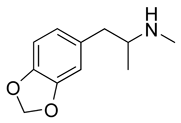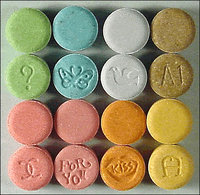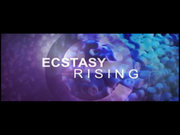A peek into your teenage daughter's bedroom reveals she is engaged in front of her personal computer. Before you assume she's plugging away at her homework, take a closer look. Rather than serving as a benign research tool, the Internet may actually become your child's drug dealer. With just a few clicks of the mouse and a credit card number, she can have illegal drugs delivered to your home.
"The Internet is changing the way everybody does business, including the bad guys," U.S. Customs Service spokesman Dean Boyd says. The days of needing to "know someone" to score drugs are over. Children need only know how to use a computer.
What can be bought
"It's all up for grabs. You can get almost anything that you want if you are willing to look for it," says Robert Stephenson of the Substance Abuse and Mental Health Services Administration (SAMHSA).
Hard-core drugs, such as heroin and cocaine, are difficult to find. Others aren't.
"In just a quick, five-minute search, I found a dozen places to buy marijuana," says William Caltrider, president of the Center for Alcohol and Drug Research and Education.
Marijuana is the most commonly used illicit drug in America, and its popularity among teens is increasing. SAMHSA found that marijuana use among youth more than doubled between 1992 and 1999. As interest in the drug has increased, so has its potency. The concentration of THC--the plant's psychoactive chemical--in American-grown marijuana has increased by five to 10 times since 1977.
Other teen favorites, such as steroids (see "Drug Primer," page 88) and the "club drugs" associated with rave parties, are easily found. Underage Web surfers can also buy legal substances, such as alcohol, cigarettes, and "herbal drugs" like ephedra. Online advertisements for legal and unregulated drugs, such as Herbal Ecstasy, promise the same high as their illegal counterparts. Prescription drugs--including such potentially addictive painkillers as Vicodin and OxyContin--are also readily available online without a prescription.
No official data about online drug sales is kept, so it is hard to know who is making such purchases. One police officer who investigates these crimes says the users he has seen are predominately middle-class whites, ages 14 to 26.
At most drug-sale sites, anyone can make a purchase with cash, a money order, or a credit card.
Some Web sites selling drugs can be found with a simple search engine, while others are hidden or require a password for access. Teens sometimes use chat rooms, message boards, and e-mail to distribute addresses to these sites, to arrange drug sales, and to share information about drugs.
Kids can go online to find drugs or rave parties (see "Drug Primer," page 88) in their city. Teens can also learn how to make illegal drugs; plenty of Web sites offer recipes, ingredients, and detailed how-to photos. Other sites, which pass themselves off as health or educational sites, give teens frightening advice, such as telling them to avoid hospital emergency rooms for treatment of a drug overdose. There are also sites that give tips for hiding drugs so they can't be found during a police search, and hints for passing a drug test.
What parents can do
Even if supervised on the Internet at home, kids often have access to it at friends' homes, at school, even at the library. But parents can protect their children.
* Start talking to your child when he is young. Drug prevention is most effective among 5- to 12-year-olds. On average, children are offered their first cigarette by third grade, says Cynthia Knowles, a drug prevention specialist for a rural New York school district.
"They'll push you away--they are kids. But you have to just stay close," Knowles says.
* Remove computers from children's bedrooms. They should have access to the Internet only in a communal area. This way you can monitor them when they are on the Web, says Winn Schwartau, author of Internet and Computer Ethics for Kids.
"Parental responsibility means you know where your child is going," Schwartau says. "Parents want to know this in a physical world and they should also know it in the virtual world."
* Create an Internet Use Agreement with your child. Give her age-appropriate restrictions on what she can do online, and set consequences if she violates the agreement.
* If you're not Internet savvy, ask your child to show you around the Web. You'll get an idea of what they see online. Review their bookmarks. If you notice any suspicious Web sites, report them to the FDA at http://www.fda.gov/oc/buyonline/buyonlineform.htm and then delete sites from the computer.
* Use a filtering system that blocks inappropriate material. Be aware that, even with such a program, kids can find questionable material, such as books hyping the "positive" effects of drugs or information on drinking games.
* If your child has a credit card, keep tabs on the billing statements and look for unusual charges. Also watch for unmarked deliveries or evidence that a child has opened a Post Office box to receive packages discreetly.
Where are the CyberPolice?
Unfortunately, there are none. The Internet is less than a decade old and the federal government has not declared who should patrol the medium. For now, most of the agencies defer to the other, making the Internet a fairly secure place for drug dealers. The Food and Drug Administration is shutting down domestic pharmacies that sell drugs without prescriptions online. The Customs Service works with foreign governments to close illegal Web pharmacies overseas, and does its best to seize shipments of illegal drugs arriving from abroad. The Drug Enforcement Administration won't disclose whether it is actively investigating Internet crimes, and the FBI says it limits investigations to "larger distribution operations" and leaves small-time Internet drug sales to local jurisdictions to handle. But of the five largest U.S. cities, only the New York Police Department has a bureau that actively investigates Internet drug crimes.
"We're still trying to iron out some of the fine points on how to most effectively attack this high-tech problem," NYPD's Sgt. Ed Maley says. "This is fairly new to everybody in law enforcement."
Although law enforcement, government, and drug prevention officials say the problem is minor, they all agree it will likely get worse before improving.
"This is certainly a window of opportunity for kids," says Knowles. "Five years from now there will probably be more policing, but right now the window is wide open for drug dealers."
STRATEGIES FOR KEEPING YOUR CHILDREN DRUG-FREE
Drug abuse experts say that children aren't likely to make their first drug purchase online. Once a child is introduced to drugs, however, the Internet could be an easy way for kids to score in the future. The best way to keep children from buying drugs online is to be certain they never start using drugs.
"If you don't use drugs, then you don't use these Web sites," says Dr. Edward Jacobs, chair of the American Academy of Pediatrics' Committee on Substance Abuse.
Phoenix House, the nation's largest drug treatment organization, gives parents seven tips for keeping children off drugs.
1. Make it clear that you don't want your children to use drugs or be friends with others who do. Talk often about the dangers of drug and alcohol use.
2. Be a good listener and ask and encourage questions. Your willingness to listen will make your child feel more comfortable about opening up to you.
3. Give honest answers. Don't make up what you don't know. If your child asks whether you've ever taken drugs, don't be afraid to say, "I made a mistake." It is a powerful way to communicate your values to your teenager.
4. Use media reports, anti-drug commercials, and school discussions about drugs to help introduce the subject. A good place for such a discussion is when you are in the car together.
5. Don't react in a way that will cut off discussion. If your child says things that shock you, respond with a calm discussion of why people use drugs and whether it is worth the risk.
6. Know where your child is and whom he or she is with.
7. Make sure that all your time with your child isn't just about rules and discipline. Hang out with your child doing fun, simple things.
DRUG PRIMER
Marijuana (pot, weed, mary jane) is usually smoked as a cigarette. Its effects include increased heart rate, dry mouth, and impaired motor skills. Users experience such health problems as bronchitis, emphysema, and asthma.
Anabolic steroids (Anavar, Anadrol, testosterone) promote muscle growth. Abuse may cause stunted growth, elevated blood pressure, and severe acne. Males may experience premature balding and abnormal breast development. Females may have a deeper voice and fewer menstrual cycles.
Rave parties. Late-night dance parties usually held in abandoned warehouses. The six "club drugs" listed below are popular because of their availability, and prices as low as $2 to $30 per "hit."
Ecstasy (X) is synthetic hallucinogenic drug that can cause anxiety, nausea, sweating, tremors, involuntary teeth clenching, muscle cramping, and brain damage. Ecstasy use has increased 500 percent in just five years.
Rohypnol (roofies, roaches, rope) is a depressant but it can cause aggression in some users. Adverse effects include low blood pressure, impaired memory, drowsiness, gastrointestinal disturbances, and urinary retention.
LSD (acid, trips, blotter) is a powerful hallucinogenic that is usually taken orally. It can produce profound adverse reactions, such as acute panic reactions, psychotic crises, and flashbacks.
Ketamine (Special K, Vitamin K) is a veterinary anesthetic that is snorted, placed in alcohol, or smoked with marijuana. Its effects, similar to LSD, last an hour or less but it can affect the senses, judgment, and coordination for 24 hours.
GHB (Liquid X, Georgia Home Boy) is a hallucinatory depressant that stimulates muscle growth. Overdoses may cause drowsiness, nausea, unconsciousness, seizures, coma, and death.
Methamphetamine (speed, crystal, crank, ice) is an addictive stimulant that can be made using over-the-counter ingredients. Effects include increased activity, decreased appetite, and a sense of well-being. After an initial six-hour "rush," users may become violent.
COPYRIGHT 2002 Meredith Corporation




